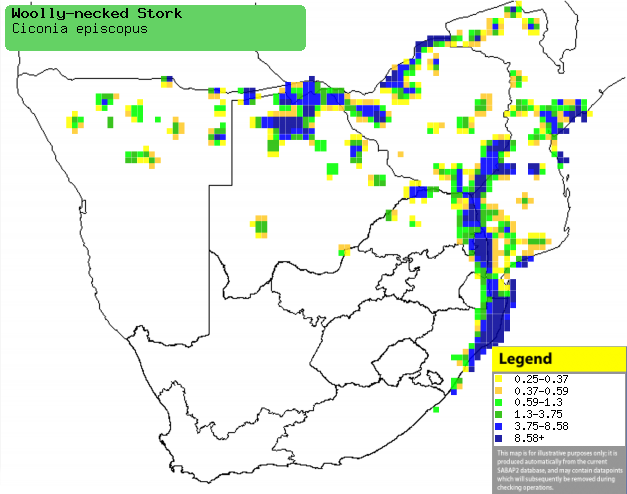|
Ciconia episcopus (Woolly-necked stork)
Wolnekooievaar [Afrikaans]; isiThandamanzi [Zulu];
Endongondongo (generic term for dark-coloured storks) [Kwangali];
Bisschopsooievaar [Dutch]; Cigogne épiscopale [French];
Wollhalsstorch [German]; Cegonha-episcopal [Portuguese]
Life
> Eukaryotes
>
Opisthokonta
> Metazoa
(animals) > Bilateria > Deuterostomia >
Chordata > Craniata > Vertebrata (vertebrates) > Gnathostomata (jawed
vertebrates) > Teleostomi (teleost fish) > Osteichthyes (bony fish) > Class:
Sarcopterygii (lobe-finned fish) > Stegocephalia (terrestrial vertebrates) >
Tetrapoda (four-legged vertebrates) > Reptiliomorpha > Amniota >
Reptilia
(reptiles) > Romeriida > Diapsida > Archosauromorpha > Archosauria >
Dinosauria (dinosaurs) > Saurischia > Theropoda (bipedal predatory
dinosaurs) > Coelurosauria > Maniraptora > Aves (birds)
> Order: Ciconiiformes
> Family: Ciconiidae
Distribution and habitat
Occurs from India and Sri Lanka to the Philippines, with a
separate population in sub-Saharan Africa. In southern Africa, it is uncommon in Mozambique, northern and southern Zimbabwe,
northern Botswana, northern Namibia (including the Caprivi Strip) and eastern
South Africa. It can occupy almost any wetland habitat, generally preferring
flood plains, rivers, pans, ponds, dams, lagoons, swamp forests, mangrove
swamps, tidal mudflats, estuaries and also man-made habitats, including golf
courses, firebreaks and roads in plantations.
|
 |
|
Distribution of Woolly-necked stork in southern
Africa, based on statistical smoothing of the records from first SA Bird
Atlas Project (©
Animal Demography unit, University of
Cape Town; smoothing by Birgit Erni and Francesca Little). Colours range
from dark blue (most common) through to yellow (least common).
See here for the latest distribution
from the SABAP2. |
Movements and migrations
Little known, as it is thought to be resident
in eastern South Africa and parts of Mozambique and Botswana, while
a non-breeding visitor to northern Namibia, Zimbabwe,
Botswana and Mozambique, staying from about November-April.
Food
It mainly eats insects and other invertebrates, doing most
of its foraging by slowly walking through water or vegetation, stabbing at prey. The following food items have been recorded
in its diet:
- Invertebrates
- insects and their larvae
- molluscs
- worms
- crabs
- Vertebrates
- fish
- frogs
- Schismaderma carens (Red toad)
- lizards
- snakes
Breeding
- Monogamous and usually a solitary nester, although it may breed in loose
colonies of 4-5 pairs.
- The nest is built by both sexes, consisting of a platform of sticks with
a central bowl lined with fine twigs, grass and green leaves. It is
typically placed in the fork of a horizontal branch of a large tree, 10-50
metres above ground or water.
- Egg-laying season is from August-December.
- It lays 2-4 eggs, which are incubated by both sexes for about 30-31
days.
- The chicks are fed and brooded by both parents, leaving the nest to
roost in a nearby tree at about 55-65 days old, becoming fully independent
roughly three weeks later.
Threats
Not threatened globally, although Near-threatened in
South Africa, due to low population numbers largely caused by habitat
destruction.
References
-
Hockey PAR, Dean WRJ and Ryan PG 2005. Roberts
- Birds of southern Africa, VIIth ed. The Trustees of the John Voelcker
Bird Book Fund, Cape Town.
|
